Main
Menu - Misc.
- Clothing/Textiles
- Medieval
Wales - Names
- Other
Medieval - Publications
- Harpy
Publications
This page last modified February
29, 2004
Archaeological Sewing
by Heather Rose Jones
copyright © 2001, 2003 all rights reserved
return to Table of Contents
Wool
Wool, especially when fulled to some extent, is resistant to ravelling, so cut
edges are not always finished and hems may only be turned once rather than twice.
The sewing thread may be wool, linen, or silk.
Wool - Seams to join fabrics: Overcast Stitch and Variants
Overcast (typically of selvedges) (Fig. 7)

- Bronze Age: Wool rectangular cloth, selvedge and cut edge joined by apparent
overcast stitches in woolen thread. [Broholm & Hald 1940 p.66]
- Medieval: Wool, overcast with butted edges. [Hedeby (northern Germany),
Hägg 1984 (9)]
Overcast of (selvedge & single- or double-fold) (Fig. 8)
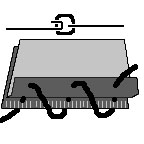
- Hallstadt: Not entirely clear, but appears to be single edge (selvedge?)
and single or double fold edge, both overcast together (through fold). Wool.
[Hundt 1987 (c)]
Overcast of (single-fold hem with hemstitch) (Fig. 9)
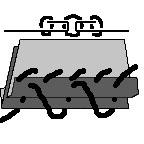
- Medieval: Wool, right sides together: short single turnover with hem stitch,
then folded edges overcast together; [Hägg 1984, Hedeby (northern Germany)
(12)]
- Medieval: Wools, right sides together: long single turnover with hem stitch,
then folded edges overcast together; [Hägg 1984, Hedeby (northern Germany),
(13)]
Overcast of (single-fold hem with hemstitch + running stitch top-stitching)
(Fig. 10)
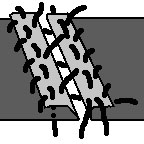
- Hallstadt: Wool, both edges double fold with hem stitch and running stitch
as top-stitching down the fold, then the folded edges overcast together. [Hundt
1960 (b) ]
Overcast of (double-fold hem with hem stitch) (Fig. 11)
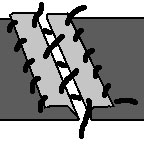
- Hallstadt: Wool, both edges have a double fold with hem stitch, then the
folds have been overcast together. [Hundt 1970]
- Medieval: Wool, right sides together: double turnover with hem stitch, then
folded edges overcast together. [Hägg 1984, Hedeby (northern Germany),
(14)]
Overcast of (double-fold hem with hemstitch + running stitch outside fold
& single-fold hem with running stitch) (Fig. 12)
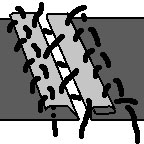
- Hallstadt: (A) double fold with hem stitch and running stitch outside the
fold, (B) single fold with running stitch through the fold; A&B folded
edges overcast together. Wool. [Hundt 1960 (c)]
Wool - Seams to join fabrics: Felled (Overlapped) Seams
Double hemstitch of raw-edge felled (typically of cut edges) (Fig. 13)
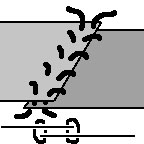
- Bronze Age: Wool, cut edges joined by overlapping slightly then overcasting
each cut edge to the other fabric. [Broholm & Hald 1940 p.71]
- Medieval: Wool, overlapped: plain overlap with hem stitch on both raw edges.
[Hägg 1984, Hedeby (northern Germany), (18)]
- Medieval: Edges are overlapped (more elaborate versions may have one or
both edges folded under to form a felled seam) and both margins have a hem
stitch through the edge of one and the fabric of the other. The example is
wool from the foot of hose. Late 14th c. London. [Crowfoot et al. 1992, p.153,
fig 125 A]
Flat-felled with hemstitch (Fig. 14)
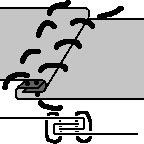
- Hallstadt: Wool, folded as for flat felled seam, with hem stitching on both
edges. [Hundt 1959]
- Hallstadt: Wool, (tube) selvedge and raw edge with slight underfold, sewn
at both edges with hem stitch. [Hundt 1960 (a)]
- Hallstadt: Wool, overlapped edges with slight single fold to center, sewn
at each edge with a hem stitch. [Hundt 1961 (b)]
- Hallstadt: Wool, folded as for flat felled seam, but hem stitch through
both edges. [Hundt 1987 (d)]
- Medieval: Wool, a "flat felled" fabric arrangement, but hem stitched at
both edges. [Hägg 1984, Hedeby (northern Germany), (21)]
- Medieval: Edges are overlapped (more elaborate versions may have one or
both edges folded under to form a felled seam) and both margins have an hem
stitch through the edge of one and the fabric of the other. Late 14th c. London.
[Crowfoot et al. 1992, p.153, fig 124 B]
Flat-felled with hem-stitch of (overlap with running stitch) (Fig. 15)
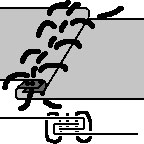
- Sub-Roman: A fragment from Steinfelder Moor shows two cut edges joined with
an elaborate flat felled seam. The two edges have been overlapped first, and
have a running stitch on (presumably) both edges of this overlap. Then the
overlapped section is folded into a Z, with the cut edges hidden in the fold,
and the folded edges are sewn to the flat fabric with a hem-stitch. [Schlabow
1976, Northern Germany Fig. 223]
Flat felled with hem-stitch of (single fold toward seam & single fold
away from seam) (Fig. 16)
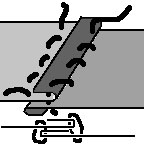
- Medieval: Wool: running stitch with mis-matched allowances as for a flat
felled seam, but the second edge folded outward (loose) and then hem stitched
at the fold. [Hägg 1984, Hedeby (northern Germany), (22)]
Wool - Seams to join fabrics: Running Stitch and Variants
Running stitch RST (Fig. 17)
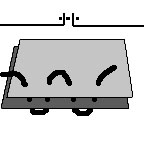
- Medieval: Running Stitch Seam. Various stitch lengths, leaves raw edges,
common in many examples. [Crowfoot et al. 1992, pl.155f, Fig. 126A]
Running stitch RST + raw edges overcast together (Fig. 18)
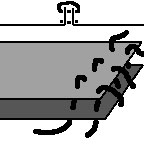
- Medieval: Wool, right sides together: running stitch seam, raw edges overcast
together. [Hägg 1984, Hedeby (northern Germany), (10)]
Running stitch RST + raw edges turned under towards each other and overcast
together (Fig. 19)
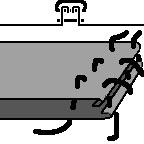
- Medieval: Wool, right sides together: running stitch seam, raw edges turned
under together and overcast. [Hägg 1984, Hedeby (northern Germany), (11)]
Running stitch RST + raw edges paired and hem-stitched to one side (Fig.
20)
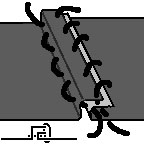
- Medieval: Wool, overlapped: either running stitch then the raw edges paired
and hem stitched to one side, or similar but both stitch lines hem stitch.
[Hägg 1984, Hedeby (northern Germany), (19)]
Running stitch RST + raw edges paired and topstitched to one side w/running-stitch
(Fig. 21)
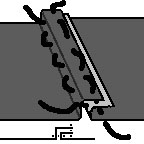
- Medieval: Wool, overlapped: either running stitch then the raw edges paired
and running stitched to one side. [Hägg 1984, Hedeby (northern Germany),
(20)]
Running stitch RST of (single-fold with no stitching) (Fig. 22 - figure shows
Thorsbjerg variant w/blanket-stitched edges)
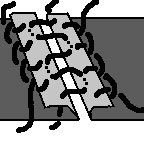
- Hallstadt: Wool, single-fold edges placed right sides together then sewn
with a running stitch through all four layers. [Hundt 1961 (a)]
- Sub-Roman: Flattened Running Stitch. Two pieces of woolen fabric are joined
(presumably at the selvedges) with a running stitch right at the edge that
is then flattened. [Hald 1980, Arden, Denmark, Fig. 292]
- Sub-Roman: Running Stitch in Folded Edge. The lengthwise sleeve seams of
the Thorsbjerg shirt has the (finished) edges folded inward, then these are
placed right sides together and are sewn with a running stitch through all
four layers. Presumably, this is relatively loose so that it can be flattened.
The fabric is a wool twill. [Schlabow 1976, Northern Germany, Fig. 142]
Running stitch WST of (single-fold with no stitching & selvedge) (Fig.
23)
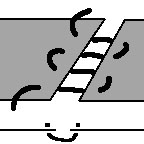
- Hallstadt: (A) single fold, (B) plain edge (selvedge?); A&B placed wrong
sides together, running stitch (through fold) then flattened. [Riek 1962]
Wool - Seams to join fabrics: Miscellaneous
Backstitch RST + running stitch top-stitching (Fig. 24)
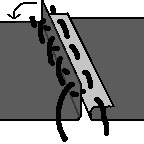
- Medieval: Hypothesized, but not clearly present in the examples. Suggested
for use in bias-cut hose (used in concert with running stitch top-stitching
on both sides of the seam). This latter is found in 16th c. hose examples
in London. [Crowfoot et al. 1992, p.156 Fig. 126 B&C]
Double-blanket stitch (of selvedges) (Fig. 25)
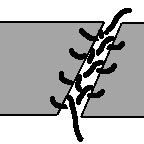
- Sub-Roman: Double-sided Blanket Stitch Join. The Damendorf skirt joins the
starting and ending borders to form the skirt tube using a very coarse stitch
that behaves as a blanket stitch alternating between the two edges (and thus
alternating directions). [Schlabow 1976, Fig. 248 , Northern Germany, but
primarily my museum notes]
- Sub-Roman: The starting and finishing borders of a piece of fabric are joined
to make a tubular skirt with a double-blanket stitch (i.e., blanket stitch
alternating sides). [Hald 1980, Fig. 439, Huldremose, Denmark]
Seam type unknown + topstitching with backstitch
- Medieval: Backstitching is added, perhaps largely as a decorative technique,
on some hems, with one or two rows in addition to the overcast. Decorative
backstitching is also found on back seams and underarm seams. [Norlund 1924]
Seam type unknown - "false" seam in solid fabric
- Medieval: Another type of decorative stitching shows that the multiple-gore
construction had made a fashion of necessity when the nature of the cut caused
some gores to the two-piece and others one-piece, the latter could be given
a "false seam" to make all appear the same, narrow size. [Norlund 1924]
Wool - Edge finishes: No Sewing
- Medieval: Woolen fabrics may have raw edges left when there is no stress
or wear put on them, and especially when they have elaborate cutting, as with
dags. 14th c. London. [Crowfoot et al. 1992 - p.196f]
Wool - Edge finishes: Blanket Stitch and Variants
Blanket stitch of (unfolded edge) (Fig. 26)
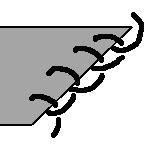
- Hallstadt: Wool, edge of unknown type (but presumably cut?) with variant
buttonhole stitch, closely set. [Hundt 1987 (b)]
- Sub-Roman: The Thorsbjerg shirt has some raw edges of the woolen fabric
finished with a blanket stitch before the seams are sewn. [Schlabow 1976,
Northern Germany, Fig. 141]
Blanket stitch + overcast stitch through blanket stitch only (Fig. 27)
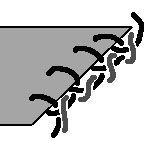
- Bronze Age: Wool body garment, fairly fulled cloth, edge finished with blanket
stitch, with a second thread whipped through the edge-loops of the blanket
stitch. [Broholm & Hald 1940 p.19]
- Bronze Age: A cut edge, presumably of a woolen fabric, is finished with
a blanket stitch that further has an overcast stitch running through the loops
of the blanket stitch only. [Hald 1980, Muldbjerg, Denmark, Fig. 300]
Blanket stitch + 2nd row of blanket stitch above it (non-overlapping) (Fig.
28)
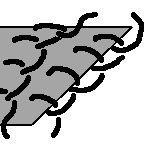
- Bronze Age: Wool, neck edge, finished with two rows of blanket stitch, one
on the edge, one butting up against it but not overlapping. [Broholm &
Hald 1940 p.68]
Blanket stitch of (narrow rolled hem) (Fig. 29)
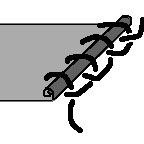
- Sub-Roman: One fragment from Thorsbjerg has a narrow rolled edge that has
been hemmed with a blanket stitch. [Schlabow 1976, Northern Germany, Fig.
202a]
Wool - Edge finishes: Hem Stitch and Variants
Hem stitch of (single fold) (Fig. 30)
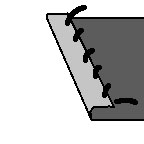
- Sub-Roman: A scarf-like woolen object with the Thorsbjerg material has one
long edge on the selvedge and the other long edge turned (once?) and hem-stitched.
[Schlabow 1976, Northern Germany, Fig. 198d]
- Medieval: Wool, single fold with hem stitch. [Hägg 1984, Hedeby (northern
Germany), (2)]
- Medieval: A single-fold hem (i.e. with raw edge exposed) is typical for
woolen fabric. 14th c. London. [Crowfoot et al. 1992 , p.156, fig 17 A, 128
A, Fig. 160]
Hem stitch of (fold number uncertain)
- Medieval: The type of stitch used for basic garment construction is not
mentioned. Hems are usually turned under and overcast. [Norlund 1924]
Hem stitch on double fold (Fig. 31)
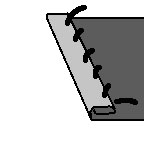
- Hallstadt: Wool, uncertain but appears to be double fold with hem stitch.
[Hundt 1960 (b)]
- Hallstadt: Wool, narrow double fold with hem stitch. (Numerous examples
of this.) [Hundt 1987 (a)]
- Sub-Roman: The Marx-Etzel shirt has a narrow, two-fold hem with hem stitch
on all free edges (neck, armholes, hem). It is possible that the side seams
have been finished in this way and then sewn together, but this is not mentioned.
[Schlabow 1976, Northern Germany, Fig. 146, 148]
- Sub-Roman: A rectangular garment (cloak?) from Röst has a double-folded
edge with hem stitch all around (all four sides). [Schlabow 1976, Northern
German, Fig. 209]
- Medieval: Wool, double fold with hem stitch. [Hägg 1984, Hedeby (northern
Germany), (3)]
- Medieval: 14th c. London. Rarely, double-fold hems are found in wool, particularly
when it may be a trailing hem. [Crowfoot et al. 1992 , p.156, fig 17 A, 128
A, Fig. 160]
Hem stitch on double fold + stem stitch on fold before folding (Fig. 32)
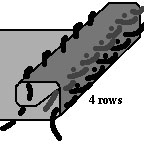
- Hallstadt: Wool, double fold with hem stitch, but before this, four rows
of white and blue decorative stem stitch have been done on what will be the
folded edge. [Hundt 1970]
Hem stitch of (double fold) + running stitch top-stitching (Fig. 33)
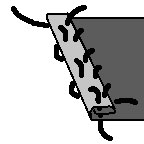
- Medieval: Wool, double fold with hem stitch, plus running stitch through
fold. [Hägg 1984, Hedeby (northern Germany), (4)]
- Medieval: Double-fold hem with hem stitch, but with a running stitch as
top-stitch next to the folded edge. [Crowfoot et al. 1992 , p.156, Fig. 127
C]
Hem stitch of (uncertain number of folds) + backstitch top-stitching (can
be multiple rows)
- Medieval: Backstitching is added, perhaps largely as a decorative technique,
on some hems, with one or two rows in addition to the overcast. Decorative
backstitching is also found on back seams and underarm seams. [Norlund 1924]
Wool - Edge finishes: Running Stitch and Variants
Running stitch of (unfolded cut edge) (Fig. 34)
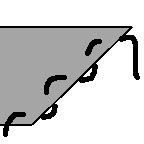
- Medieval: Wool, running stitch along edge (no fold, purpose unclear). [Hägg
1984, Hedeby (northern Germany), (6)]
Running stitch of (single fold) (Fig. 35)
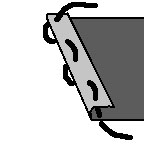
- Medieval: Woolen fabric may have a single-fold hem with a running stitch.
Wool sewn with linen thread, early 13th c. London. [Crowfoot et al. 1992,
p.156, Fig. 127B]
Running stitch of (double-fold edge & folded main fabric) (Fig. 36)
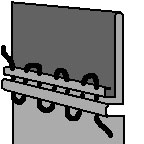
- Sub-Roman: The waist finish of the Thorsbjerg pants involves folding the
fabric down from the top, right sides together (i.e., wrong side showing)
then folding both the cut edge back slightly and folding the lower fabric
back to leave a folded edge matching the folded edge of the cut part. These
two folds are sewn together with a running stitch and then flattened slightly.
[Schlabow 1976, Northern Germany, Fig. 169]
Wool - Edge finishes: Miscellaneous
Overcast stitch of (rolled hem) (Fig. 37)
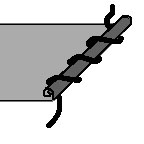
- Medieval: Wool: rolled hem with overcast stitch. [Hägg 1984, Hedeby
(northern Germany), (1)]
Herringbone stitch of (single fold) (Fig. 38)
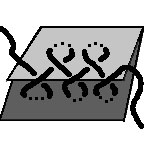
- Medieval: Wool, single fold with herringbone stitch. [Hägg 1984, Hedeby
(northern Germany), (5)]
Unknown folded hem + applied cord on edge (application method unspecified)
- Medieval: Twisted or plaited cords are used to edge and decorate necks,
wrists, pocket slits, and the occasional hem. (There is no mention of whether
this was in addition to turning and overcasting or, in some fashion, instead
of it.) The button-fronted coat has the collar and front opening edged with
a thinner, lighter fabric than the main fabric. (Given the narrow size of
the decorative cords, I wonder if they may have been done in decorative colors
originally, but no mention is made of this.) [Norlund 1924]
Wool - Edges with applied facings
Unknown (running?) stitch RST of (fabric and facing) + hemstitch of (single-fold
of facing to wrong side of fabric) (Fig. 39)
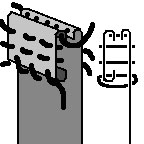
- Medieval: A narrow straight-grain band of silk is used to face a neckline
on a woolen fabric. The band has been sewn to the wool right sides together
with an unknown stitch (but probably running stitch), then turned, with the
edged turned under and overcast to the main fabric along the edge. After this,
two rows of running stitch (in the wool color) have been added. 2nd quarter
of the 14th century London. [Crowfoot et al. 1992 , plate 2 B, p.158, Fig.
131]
Hem stitch of (tape facing folded over cut edge) (Fig. 40)
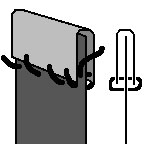
- Medieval: A silk tape is folded in half over the edge and then hem-stitched,
possibly through both edges at once? The example is binding the edge of a
leather purse. Late 14th c. London [Crowfoot et al. 1992 , p.158 Fig. 130,
Fig. 153B]
Wool - Other Stitch Purposes
Cord-ties as fastening method (Fig. 41)
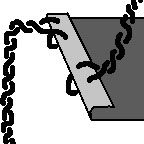
- Sub-Roman: The side seams of the Thorsbjerg shirt are finished by turning
the edge under once, then taking a single stitch from the wrong side through
and back, the ends of which are plied together. Pairs of these ties on the
front and back pieces are then tied to fasten the shirt. There is no indication
of any other finish or stitch on these edges. This is also found on the lower
leg opening of the Thorsbjerg pants. [Schlabow 1976 Northern Germany, Fig.
141]
Seam finish (decorative) - fishbone stitch over running stitch WST seam (Fig.
42)
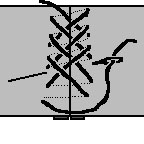
- Medieval: A cushion cover has a seam finish using fishbone stitch over the
actual seam (which appears possibly to be a wrong-sides-together running stitch?).
Although this has a similar appearance to herringbone stitch, the sewing technique
is different. This may be primarily decorative. [Hald 1980, Mammen, Denmark,
Fig. 296]
Tucks in non-edge fabric (Fig. 43, 44)
Fig. 43 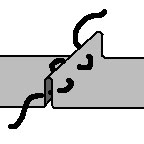 Fig. 44
Fig. 44 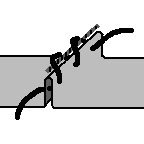
- Medieval: Wool: tucks folded and sewn with a running stitch. [Hägg
1984, Hedeby (northern Germany), (7)]
- Medieval: Wool, folded RST (but nothing to keep the fold in place?) and
a cord overcast onto the fold. [Hägg 1984, Hedeby (northern Germany),
(8)]
Joining middles of fabrics (purpose unclear, but not quilting) (Fig. 45-47)
Fig. 45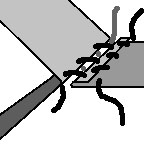 Fig. 46
Fig. 46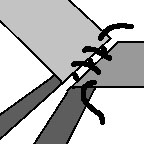 Fig. 47
Fig. 47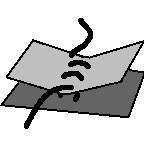
- Medieval: Wool: A folded middle, B single folded edge with hem stitch, both
folds overcast together. [Hägg 1984, Hedeby (northern Germany), (15)]
- Medieval: Wool: A folded middle, B flat middle, edge A overcast to B. [Hägg
1984, Hedeby (northern Germany), (16)]
- Medieval: Wool: both flat middles, overcast together. [Hägg 1984, Hedeby
(northern Germany), (17)]
Quilting
- Medieval: A silk lining has been sewn to a woolen ground fabric with rows
of parallel running stitch forming a triangular pattern. There is no evidence
of padding, though. [Crowfoot et al. 1992 , p.174, Fig. 151]
Worked holes (Fig. 48, 49)
Fig. 48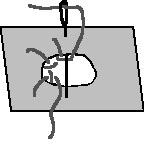 Fig. 49
Fig. 49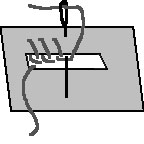
- Medieval: Eyelets are worked in two rounds of buttonhole stitch in silk,
worked through both the main woolen fabric and a narrow silk facing strip.
Late 14th c. London. [Crowfoot et al. 1992 , p.164, Fig. 139]
- Medieval: Buttonholes: worked in silk buttonhole stitch through the main
woolen fabric and a silk facing. The slit is perpendicular to the edge. 14th
c. London. [Crowfoot et al. 1992 , p.169f, Fig. 145]
Pleating
- Medieval: Slight evidence for gathering or pleating using two or three parallel
rows of running stitches. 14th c. London. [Crowfoot et al. 1992 , p.173f]
(Similarly, Norlund.)
Return to Table of Contents -- Continue
to next section
This site belongs to Heather
Rose Jones. Contact me regarding anything beyond personal, individual use
of this material.
Unless otherwise noted, all contents are copyright by Heather Rose Jones, all
rights reserved.





































 Fig. 44
Fig. 44 
 Fig. 46
Fig. 46 Fig. 47
Fig. 47
 Fig. 49
Fig. 49